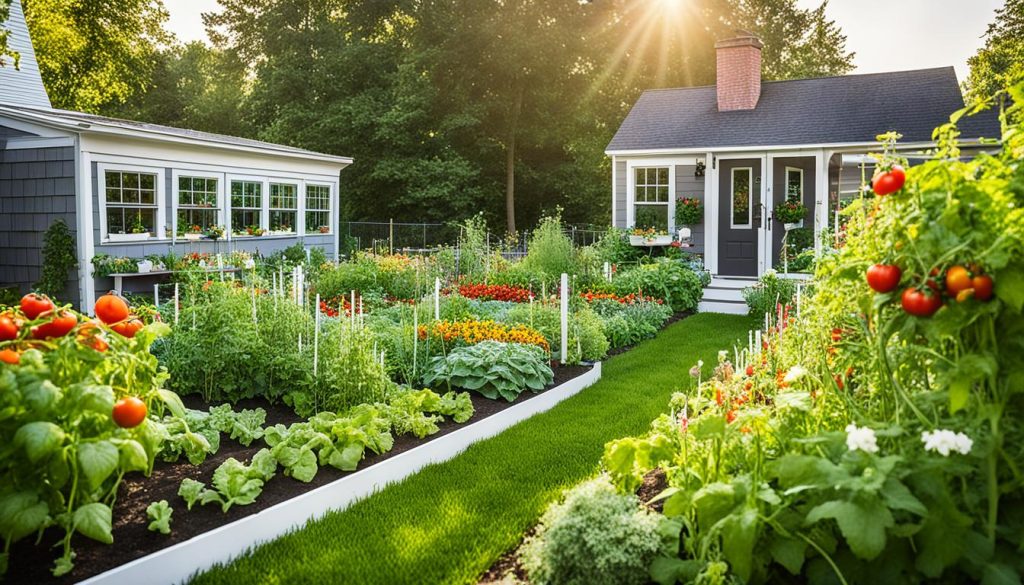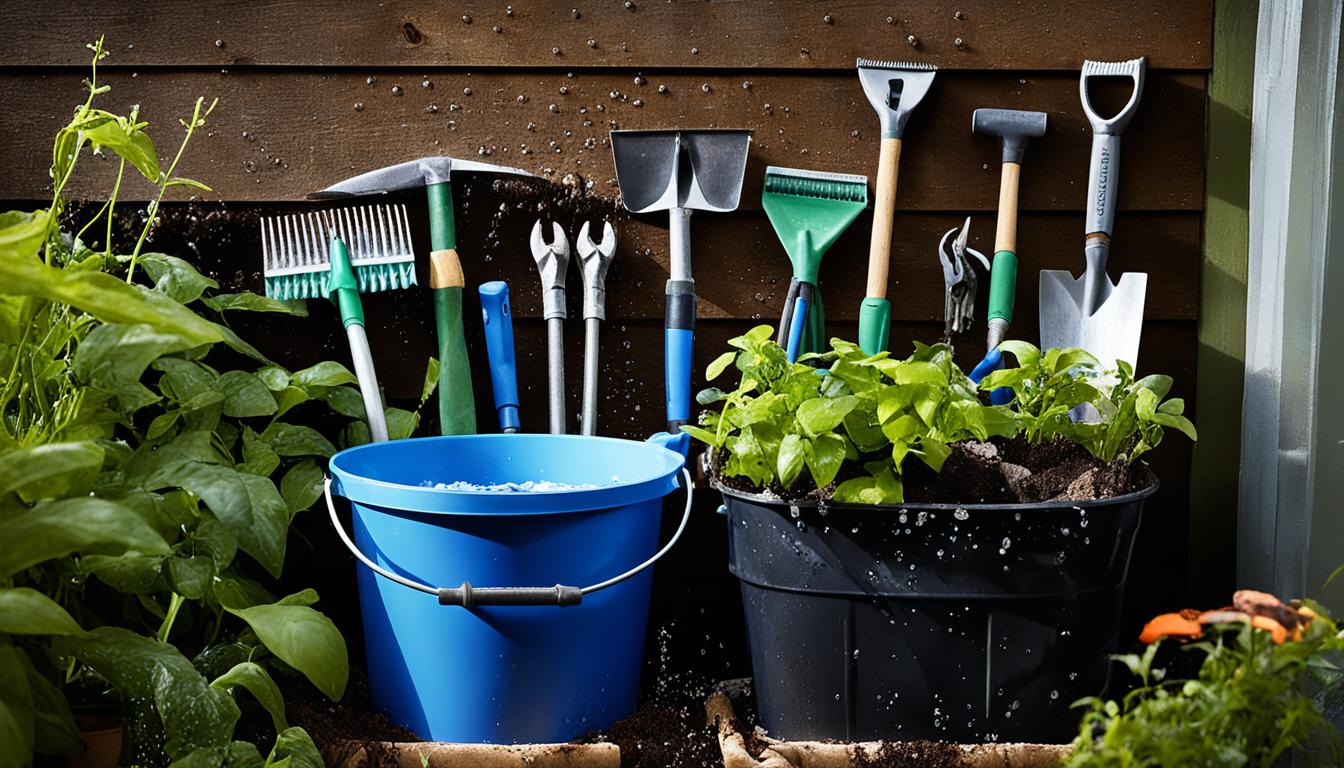Welcome to the world of home gardening! It doesn’t matter if you have a big backyard or a small balcony. Gardening can make you happy, calm, and give you fresh, healthy food. We’ll give you simple tips to start your own home vegetable garden, even if you’re a beginner. Get ready to start and grow your green thumb!
Growing your own garden has many benefits. It helps you connect with nature and feel proud of your food. With some planning and the right methods, you can make a beautiful urban garden or container garden. We’ll show you how to turn your space into a lively herb garden or indoor garden.
The journey of gardening at home is as rewarding as the harvest. Our easy tips will help you become a confident home gardener. Let’s start and learn how to make your own green paradise at home.
Introduction to Home Gardening
Gardening at home is a rewarding hobby that brings many benefits. It’s great whether you have a big backyard or a small patio. You’ll connect with nature, boost your mental health, and value the food you eat more.
Benefits of Gardening at Home
Home gardening has many advantages that go beyond the garden. Key benefits include:
- Access to fresh, organic produce
- Improved physical and mental health
- Reduced stress and anxiety
- Increased exercise and outdoor activity
- Opportunities to learn new skills and hobbies
- Positive environmental impact through sustainable practices
Getting Started: Essential Supplies
To start your home gardening, you’ll need some basic supplies. The items you need may change based on your garden’s size and type. Here are the must-haves:
- Quality gardening tools (trowel, pruning shears, gloves, etc.)
- Nutrient-rich soil or potting mix
- Healthy seedlings or seeds for your plants
- Containers or raised beds (if you don’t have a yard)
- Watering equipment (hose, sprinkler, or drip system)
- Pest control solutions (organic or natural methods)
With the right supplies and some patience, you can turn your home into a lush garden full of fresh produce.
Choosing the Right Plants
Choosing the right plants is key to a successful home garden. Whether you garden indoors or outdoors, picking the right plants is crucial. Let’s look at some important things to think about when picking plants for your garden.
Matching Plants to Your Climate
First, understand your local climate. Different plants like different temperatures, rainfall, and sunlight. Find out which plants are best for your area’s weather. This helps your plants grow well.
Evaluating Sunlight Requirements
How much sunlight your garden or indoor space gets is important. Some plants love full sun, while others prefer shade or low light. Measure your space’s sunlight and pick plants that fit, whether for outdoor plants or indoor plants.
Considering Plant Size and Growth Habits
Think about the size and growth of the plants you choose. Make sure you have enough room for them, whether they’re vines, trees, or succulents. This makes your garden look good and balanced.
| Plant Type | Sunlight Needs | Mature Size |
|---|---|---|
| Tomatoes | Full Sun | 3-6 feet tall |
| Zinnias | Full Sun | 12-36 inches tall |
| Philodendrons | Partial Shade | 3-10 feet tall |
| Snake Plants | Low Light | 1-4 feet tall |
By thinking about these factors, you can choose the right plants for your home garden. You’ll have a beautiful, thriving garden, whether with indoor plants or outdoor plants.
Preparing the Soil for Planting
Starting a home garden begins with the soil. Healthy soil is crucial for feeding your plants and helping them grow well. We’ll look at the importance of soil testing and adding nutrients. We’ll also talk about how composting can make your soil rich in nutrients.
Soil Testing and Amendments
Testing your soil before planting is a must. It tells you the pH level and nutrient levels. This info helps you fix any problems. Then, you can add things like lime, compost, or fertilizers to make the soil perfect for your plants.
Composting for Nutrient-Rich Soil
Composting is great for making your soil better. It turns kitchen and yard waste into a nutrient-rich soil booster. This not only cuts down on waste but also makes your plants stronger and more productive.
| Soil Preparation Step | Benefits |
|---|---|
| Soil Testing | Identifies nutrient deficiencies and pH imbalances |
| Soil Amendments | Corrects soil issues and creates the optimal growing conditions |
| Composting | Adds nutrient-rich organic matter to the soil |
Preparing your soil well sets the stage for a great garden. With the right soil, your plants will be healthier and more productive. They’ll be able to grow better and give you a big harvest.
“The key to a successful garden is in the soil. Invest the time to test and amend your soil, and you’ll be rewarded with a bountiful harvest.”
Containers and Raised Beds
If you’re short on outdoor space, don’t worry. Container gardening and raised beds are great for small gardens. They let you grow your own food even in tiny spots.
Advantages of Container Gardening
Container gardening is perfect for small spaces like balconies or patios. You can use the right containers and soil to grow veggies, herbs, and some fruits. The benefits include:
- Easily control the soil quality and drainage
- Customize the container size to suit your needs
- Portability – move containers around to optimize sunlight
- Fewer weeds and pests compared to in-ground gardens
- Ideal for small-space gardening, including raised beds and vertical gardening
When picking containers, look for ones with good drainage. Choose larger sizes to support your plants’ roots. This helps your garden do well.
“Container gardening is the ideal solution for anyone with limited outdoor space. It allows you to grow a wide variety of plants, while enjoying the benefits of a personal garden.”
Watering and Irrigation Techniques
Proper watering is key for your home garden’s health and growth. Using efficient watering and irrigation can feed your plants and save water. We’ll look at ways to make your garden thrive and use less water.
Drip Irrigation: The Water-Wise Solution
Drip irrigation sends water right to your plants’ roots. This cuts down on evaporation and runoff. It’s a smart way to use less water than sprinklers. Think about getting a drip system to water your plants well without wasting water.
Timely Watering: When and How Much?
How often you should water depends on your climate, soil, and plants. Water in the early morning or evening to reduce evaporation. Change how often and how long you water based on the weather and how your plants look, like if leaves are wilting or soil is dry.
- Water deeply to help roots grow deeper and be more resistant to drought.
- Use a soil moisture meter to know when your plants need water.
- Put plants with the same water needs together for better watering plans.
Capturing Rainwater: Nature’s Contribution
Harvesting rainwater is a great way to add to your garden’s water supply and use less city water. Put up rain barrels or cisterns to catch and save rainwater for later. This saves water, helps during droughts, and cuts down on stormwater runoff.
“The key to successful gardening is understanding the unique water needs of your plants and tailoring your watering techniques accordingly.”
Using smart watering methods can make your garden healthy and help with water conservation in your area. Focus on your plants’ health and be careful with your water use for a greener, eco-friendly garden.
How to Gardening at Home for Maximum Yield
Want to make the most of your home vegetable garden? We’ve got the best tips and tricks for you! Learn how to boost your gardening productivity and increase your garden yield.
One key to a great harvest is planting efficiently. Try succession planting. This means planting seeds or seedlings at different times for a steady supply of fresh produce all season.
- First, make a planting schedule based on how long it takes your crops to grow.
- Plant quick-growing veggies like radishes, lettuce, and spinach between slower-growing plants like tomatoes or peppers.
- Keep planting the same crops every few weeks to keep the harvest going.
To make the most of your home vegetable garden, use space-saving ideas. Try vertical gardening with plants like cucumbers or pole beans. Or, use raised beds or containers for a neat layout.
| Technique | Benefits |
|---|---|
| Succession Planting | Extends the harvest season, provides a continuous supply of fresh produce |
| Vertical Gardening | Saves space, increases yields in small-scale gardens |
| Raised Beds | Improves drainage, allows for better soil control, and minimizes weeds |
With these techniques, you can turn your home vegetable garden into a top-performing garden. Enjoy a bountiful harvest all season long by maximizing your gardening yield.

Pest and Disease Management
Keeping your home garden healthy means watching out for pests and diseases. Using eco-friendly, organic pest control helps protect your plants and the environment. We’ll look at natural ways to keep pests and diseases away from your garden.
Organic Pest Control Methods
Organic pest control uses natural, safe ways to keep insects and animals out of your garden. These methods are good for the planet and keep your garden’s ecosystem balanced. Here are some organic pest control tips:
- Introduce beneficial insects like ladybugs, lacewings, and praying mantis to eat common garden pests.
- Use natural repellents such as garlic, pepper, or neem oil to keep pests away without hurting your plants.
- Put up physical barriers like row covers or mesh netting to stop pests from reaching your plants.
- Practice companion planting, where you place certain plants together to naturally deter pests.
- Keep your garden clean by removing weeds, fallen leaves, and debris that pests and diseases can hide in.
Using these organic pest control methods helps you manage garden problems while keeping your garden eco-friendly.
Disease Management Strategies
It’s also key to prevent and manage plant diseases in your garden. Many diseases can be treated with natural, sustainable ways:
- Keep your soil healthy by adding organic matter and ensuring it has the right nutrients.
- Pick plants that are resistant to diseases and fit your local climate and soil.
- Use crop rotation to stop soil-borne pathogens from building up.
- Watch your plants for early signs of disease and deal with them quickly to stop them from spreading.
- Remove and throw away infected plant parts to stop diseases from spreading further.
By using these disease management strategies with your organic pest control, you can have a eco-friendly home garden that fights off common problems and grows well.
Pruning and Maintenance
Keeping a garden healthy and looking great needs careful pruning and upkeep. Using the right pruning methods helps plants grow better, improves air flow, and makes your garden look better. Also, tasks like weeding, mulching, and cleaning are key to keeping your garden alive and looking good.
Pruning at the right time is very important. Each plant prunes best at certain times of the year. For example, perennials do well in spring, while fruit trees and shrubs need attention in late winter or early spring. Learning how to prune takes time, but it’s worth it.
- Prune plants that flower after they bloom to get more growth and flowers next year.
- Cut back perennials in early spring for new leaves and flowers.
- Trim fruit trees and shrubs in late winter or early spring before they start growing new leaves.
- Take out dead, damaged, or sick plant parts all growing season to keep plants healthy and looking good.
Regular tasks like weeding, mulching, and cleaning are also key for a great garden. Weeding makes your garden look better and stops unwanted plants from taking over. Mulching keeps soil moist, stops weeds, and helps plants grow strong. Cleaning up leaves, debris, and old flowers keeps your garden neat and well-kept.
“A well-tended garden is a source of pride and joy, both for the gardener and those who enjoy its beauty.”
Learning how to prune and keeping up with garden care makes your garden lush, vibrant, and peaceful. With some time and effort, your garden will flourish and bring joy to you and your loved ones for many years.

Small-Space Gardening Ideas
Gardening at home doesn’t need a big space. With creativity and the right methods, you can grow your own food in small urban areas. Vertical gardening is a great way to use space well and make a garden in small spots.
Vertical Gardening Techniques
Vertical gardening means growing plants up instead of out. You can do this with trellises, hanging baskets, or wall-mounted holders. Here are some top ideas for vertical gardening:
- Climbing vines: Grow veggies like tomatoes, cucumbers, or beans on trellises or cages.
- Hanging baskets: Hang baskets with plants, herbs, or small veggies from walls, fences, or ceilings.
- Shelving systems: Use shelves or tiered stands to make a compact, efficient garden.
- Vertical towers: Build stackable planters or towers for growing many plants in a small area.
Using vertical gardening methods lets you make the most of your small-space gardening space. You can get a lot of harvest even in tiny urban spots. With creativity and planning, you can turn your small outdoor area or balcony into a lush urban gardening spot.
Indoor Gardening: Herbs and Houseplants
Gardening isn’t just for the outdoors. You can also grow a garden inside with herbs and houseplants. This way, you can have fresh herbs and beautiful plants all year.
Indoor herb gardens have many perks. Herbs like basil, mint, and rosemary make your cooking taste better. They also clean the air in your home. Plus, you won’t have to go outside for fresh ingredients.
Houseplants are more than just pretty. They help clean the air, reduce stress, and can make you more productive. There are many types of plants for every space and level of care.
Cultivating an Indoor Herb Garden
To start your indoor herb garden, pick a spot that gets at least 6 hours of sunlight a day. Use self-watering containers or hydroponic systems to make watering easier. Make sure your herbs get the right amount of water, light, and food to grow well.
Caring for Houseplants
Pay attention to what your houseplants need. Some like bright light, while others prefer low light. Learn about the best soil, water schedule, and humidity for your plants. Regularly trim and check for pests to keep your garden healthy.
Indoor herb gardens and houseplants can bring nature inside. With a bit of care, you can enjoy the perks of indoor gardening all year.

Harvesting and Preserving Your Produce
Enjoying the fresh, flavorful produce from your garden is a big reward. As your crops get ready, learn how to harvest and preserve them well. These skills are key for anyone, whether you’re new to gardening or have been doing it for years. They help you get the best out of your home-grown food.
Harvesting with Care
Harvesting right is crucial for keeping your produce tasty and fresh. Here are some tips:
- Pick your crops when they’re perfectly ripe for the best flavor and nutrients.
- Be gentle with your fruits and veggies to prevent damage and spoilage.
- Use sharp tools like pruners or knives for clean cuts that don’t harm the plant.
- Pick your harvest early in the morning when plants are cool and well-hydrated.
Preserving the Harvest
After harvesting, it’s time to preserve your produce. You can use home canning, freezing, or other methods to keep your harvesting garden produce and preserving fruits and vegetables fresh for later.
| Preservation Method | Pros | Cons |
|---|---|---|
| Canning | – Shelf-stable for 1-5 years – Keeps texture and flavor – Gives you produce all year |
– Needs special equipment – Takes a lot of time |
| Freezing | – Quick and simple – Keeps nutrients well – Little prep needed |
– Doesn’t last long (6-12 months) – Texture and flavor might change over time |
| Drying | – Lasts for years – Takes up little space and is easy to store – Keeps some nutrients |
– Takes a lot of time – Needs special equipment |
Learning home canning and other preservation methods lets you enjoy your garden’s bounty even after the growing season ends.
Conclusion
Your journey in home gardening is now ready to begin. Growing your own food is more than a hobby. It’s a way to improve your health, save money, and connect with nature. Embrace the process, try new plants, and learn from any mistakes.
Whether you’re starting small or turning your backyard into a garden, this guide has you covered. Get your hands dirty and enjoy watching your food grow. The journey of home gardening is full of surprises and rewards – cherish every moment.
So, what are you waiting for? It’s time to start gardening! Wishing you a fruitful and inspiring home gardening experience.


